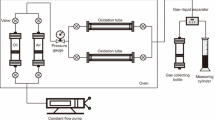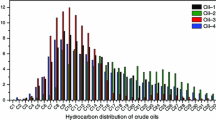Abstract
This research aimed at the investigation of the effect of formation factors on the light crude oil during the high temperature air injection process. For this purpose, thermogravimetric and Fourier Transform Infrared Spectroscopy techniques were combined to investigate the light crude oil and oil mixed with formation water and sand at 58, 250, and 450 °C, respectively. The results showed that at different temperature range, the mass drop rate presented different trend and the formation water and sand increased the activation energy of the oxidation reaction. The formation sand exhibited the excellent catalytic effect at relative low temperature. The oxygen addition reaction massively was trigged at 250 °C, and the bond scission reaction dominated at 450 °C. With different additives at different temperature range, the type, concentration, and produced timing of the products presented different tendency.










Similar content being viewed by others
References
Greaves M, Ren SR, Rathbone RR. Air injection technique (LTO process) for IOR from light oil reservoirs: oxidation rate and displacement studies. In: Improved Oil Recovery Symposium; 19–22 April, Tulsa, Oklahoma, 1998.
Greaves M, Young TJ, El-Usta S, Rathbone RR, Ren SR, Xia TX. Air injection into light and medium heavy oil reservoirs. Chem Eng Res Des. 2000;78(5):721–30. doi:10.1205/026387600527905.
Ursenbach MG, Moore RG, Menhta SA. Air injection in heavy oil reservoirs—a process whose time has come (again). J Can Pet Technol. 2009;49(1):48–54.
DAbbous MK, Fulton PF. Low-temperature-oxidation reaction kinetics and effects on the in situ combustion process. SPE Journal. 1974;14(3):253–62.
Mamora D. Kinetics of in situ combustion. Fossil Energy Report; 1993.
Clara C, Durandeau M, Quenault G, Nguyen T-H. Laboratory studies for light-oil air injection projects: potential application in Handil field. SPE Reservoir Eval Eng. 2000;3(3):239–48.
Barzin Y, Moore RG, Mehta SA, Ursenbach MG, Tabasnejad F. Impact of distillation on the combustion kinetics of high pressure air injection (HPAI). In: 2010 SPE improved Oil Recovery Symposium; 24–28 April 2010, Tulsa, Oklahoma.
Barzin Y, Moore RG, Mallory DG, Ursenbach MG, Tabasinejad F. Role of vapor phase in oxidation/combustion kinetics of high-pressure air injection (HPAI). In: SPE Annual Technical Conference and Exhibition; 19–22 September 2010, Florence.
Chen Z, Wang L, Duan Q, Zhang L, Ren S. High-pressure air injection for improved oil recovery: low-temperature oxidation models and thermal effect. Energy Fuels. 2013;27(2):780–6. doi:10.1021/ef301877a.
Kök MV, Gul KG. Combustion characteristics and kinetic analysis of Turkish crude oils and their SARA fractions by DSC. J Therm Anal Calorim. 2013;114(1):269–75. doi:10.1007/s10973-013-3256-3.
Mothé MG, Mothé CG, de Carvalho CHM, de Oliveira MCK. Thermal investigation of heavy crude oil by simultaneous TG-DSC-FTIR and EDXRF. J Therm Anal Calorim. 2013;113(2):525–31.
Vidal Vargas JA, dos Santos RG, Trevisan OV. Evaluation of crude oil oxidation by accelerating rate calorimetry: effects of combustion process variables on thermal and kinetic parameters. J Therm Anal Calorim. 2013;113(2):897–908.
Shallcross DC, De los Rlos CF, Castanier DC, Brigham WE. Modifying in situ combustion performance by the use of water soluble additives. Reservoir Eng. 1991;6(3):287–94.
Drici Q, Vossoughi S. Catalytic effect of heavy metal oxides on crude oil combustion. SPE Reservoir Eng. 1987;2(4):591–5.
Kök MV, Gundogar AS. Combustion characteristics of lignite and oil shale samples by thermal analysis techniques. J Therm Anal Calorim. 2010;99:779–83.
Kök MV, Gundogar AS. Effect of different clay concentrations on crude oil combustion kinetics by thermogravimetry. J Therm Anal Calorim. 2009;99(3):779–83. doi:10.1007/s10973-009-0377-9.
Kök MV. Non-isothermal DSC and TG/DTG analysis of the combustion of Silopi asphaltites. J Therm Anal Calorim. 2007;88(3):663–8.
Kök MV, Acar C. Kinetics of crude oil combustion. J Therm Anal Calorim. 2006;83(2):445–9.
Kök MV. Use of thermal equipment to evaluate crude oils. Thermochinmica Acta. 1993;214(2):315–24.
Kok M. The thermal characterization of crude oils in a limestone matrix of different particle size. Energy Sources. 2014;36(9):923–8.
Gundogar AS, Kok MV. Thermal characterization, combustion and kinetics of different origin crude oils. Fuel. 2014;123:59–65.
Mothé MG, Carvalho CH, Sérvulo EF, Mothé CG. Kinetic study of heavy crude oils by thermal analysis. J Therm Anal Calorim. 2013;111(1):663–8.
Ambalae A, Mahinpey N, Freitag N. Thermogravimetric studies on pyrolysis and combustion behavior of a heavy oil and its asphaltenes. Energy Fuels. 2006;20:560–5.
Su W, Fang M, Cen J, Li C, Luo Z, Cen K. Influence of metal additives on pyrolysis behavior of bituminous coal by TG-FTIR analysis. 2013:149–59. doi:10.1007/978-3-642-30445-3_23.
Hamedishokrlu Y, Maham Y, Tan X, Babadagli T, Gray M. Enhancement of the efficiency of in situ combustion technique for heavy-oil recovery by application of nickel ions. Fuel. 2012;105:397–407. doi:10.1016/j.fuel.2012.07.018.
He B, Chen Q, Castanier LM, Kovscek AR. Improved In-situ combustion performance with metallic salt additives. In: SPE Western Regional Meeting, 30 March–1 April 2005, Irvine, CA, Society of Petroleum Engineers; 2005.
Celebioglu D, Bagci S. The effects of metallic catalysts on light crude oil oxidation in limestone medium. Fuel Process Technol. 2002;79:29–49.
Kök MV, Iscan AG. Catalytic effects of metallic additives on the combustion properties of crude oils by thermal analysis techniques. J Therm Anal Calorim. 2001;64:1311–8.
Castanier LM, Banena CJ, Holt RJ, Brigham WEB. In situ combustion with metallic additives. In: Second Latin American Petroleum Engineering Conference, 8–11 March, Venezuela 1992.
Vyazovkin S, Burnham AK, Perez-Maqueda LA, Popescu C, Sbirrazzuoli N. ICTAC Kinetics committee recommendations for performing kinetic computations on thermal analysis data. Thermochim Acta. 2011;520:1–19.
Kok MV, Gundogar AS. DSC study on combustion and pyrolysis behaviors of Turkish crude oils. Fuel Process Technol. 2013;116:110–5. doi:10.1016/j.fuproc.2013.05.001.
Kök MV. Effect of pressure and particle size on the thermal cracking of light crude oils in sandstone matrix. J Therm Anal Calorim. 2009;97(2):403–7.
Lee DG, Noureldin NA. Effect of water on the low-temperature oxidation of heavy oil. Energy Fuels. 1989;3:713–5.
Li Y-B, Zhao J-Z, Pu W-F, Jia H, Peng H, Zhong D, et al. Catalytic effect analysis of metallic additives on light crude oil by TG and DSC tests. J Therm Anal Calorim. 2013;113:579–87.
Li Y-B, Zhao J-Z, Pu W-F, Peng H, Zhong D, Hu Z-W. A method based on the Harcourt and Esson equation to estimate the catalytic effect of metallic additives on light crude oil. J Alloy Compd. 2014;585:7–13.
Acknowledgements
The authors would like to express their appreciation for the support provided by the special fund of China’s central government for the development of local colleges and universities—the project of national first-level discipline in Oil and Gas Engineering.
Author information
Authors and Affiliations
Corresponding author
Electronic supplementary material
Below is the link to the electronic supplementary material.
Rights and permissions
About this article
Cite this article
Li, YB., Pu, WF., Sun, L. et al. Effect of formation factors on light crude oil oxidation via TG-FTIR. J Therm Anal Calorim 118, 1685–1695 (2014). https://doi.org/10.1007/s10973-014-4046-2
Received:
Accepted:
Published:
Issue Date:
DOI: https://doi.org/10.1007/s10973-014-4046-2




